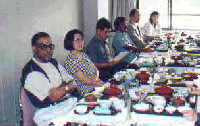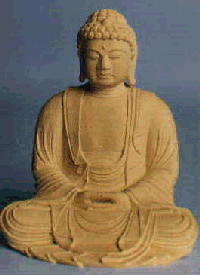
Education in an Information Age
- as seen in Japan
28 September
The day was set aside for sight seeing of the Miyajima Island. On our way we stopped at an elementary school to see its annual sports festival. Eight hundred children together with their parents had come to the school. Children of the school were divided into two groups, red and white, the colours of the Japanese national flag. There were no individual events to compete. All the children of each grade were involved in the games and activities. From the beginning children in Japan are encouraged to work together. Recognition comes to the group for collective effort. The visit to this elementary school like all the programmes arranged so far was planned with minute detail.
Crossing the strait to the Miyajima island took about l0 minutes by ferry. The hosts had arranged a lunch for the participants. While walking to the hotel I inhaled strong smell of roasting seafood. It produced nausea and I lost my appetite.

Inside the restaurant there was a Japanese garden with flowing water. It restored my spirit and I joined the group for lunch. The meal turned out to be a fully vegetarian fare but of Japanese style. This was perhaps a pragmatic solution to the dietary restrictions of an international gathering of guests. The meal was good. I liked the soup and ate with chopsticks, straight out of the bowl, the boiled rice sprinkled with sesame seeds. Tabata, who is a Professor in the Hiroshima University and a constant companion in all activities arranged for the group, clarified that before entering shrines the custom is to eat food what is considered pure and spiritually uplifting. Therefore, even the Japanese turn pure vegetarian when they visit a temple or a shrine. Miyajima's Itsukushima shrine is one of the three monuments of national importance in Japan. The shrine is at the sea level. At high tide sea water submerges a metre of its height. I liked the Noh theatre in the shrine complex. It is more than four hundred years old. Its wooden screen has paintings of pine and bamboo trees. Japanese are experts at shaping trees. I saw a pine tree shaped like a 5 storied pagoda. I was told that four successive generations of a family had contributed in giving shape to this pine tree. There is a pine tree near the pagoda tree with 25 metres long branches almost grazing the ground. They appear like arms extending on either side but are more appropriately called the pine-moustaches.

There were many souvenir shops in the island. I decided to look for a Japanese Buddha. Needless to say that Japan now is one of the costliest countries of the world. It did not therefore come as a surprise that handicraft items were beyond my funds. I took the help of a Japanese student to find for me a Kamakura Buddha. He was not hopeful as he said that in the vicinity of a shrine only the Japanese gods are sold. What I used to consider as the laughing Buddha, he pointed out is the Japanese god of wealth called Hote. I picked up a pot bellied Hote and found that it indeed was a piggy bank. A small figure of a wooden Kamakura Buddha was shown to me. As it was priced at Yen 25,000, I took no further interest in it. The shop owner took me inside his warehouse and showed sculptures from India. He said that as I was from India he would reduce the price by half and offered the Buddha to me for Yen 12,500. I felt that even this price I cannot afford. It exceeded US$ 100. The shopkeeper said that he can reduce the price further to Yen 10,000 and no less. He remarked that small seals made out of the same wood used in the Kamakura Buddha cost Yen 3,600. I realised that money asked should be seen in the context of wages that would have been paid to the sculptor here in Japan and not what a sculptor in India would have got for the same effort. I purchased the small figure of Kamakara Buddha. It has the peaceful look of an aged Buddha and is beautiful.

In the evening I decided to explore once again the computer shops for colour scanner. Today, I decided to play brave and confronted a salesman to find whether he spoke English. My luck was good. The salesman turned out to be a student of the Hiroshima University. He said that he could speak some English. He asked me whether I was a professor and whether I was from India. When I answered 'yes' to both questions, he said that he wants to learn about M.K. Gandhi and has planned a visit to India in March l998. He pointed out a scanner made in Taiwan priced less than what I had paid for the Buddha. He said that he would find from the Internet whether an English driver for this model can be downloaded.